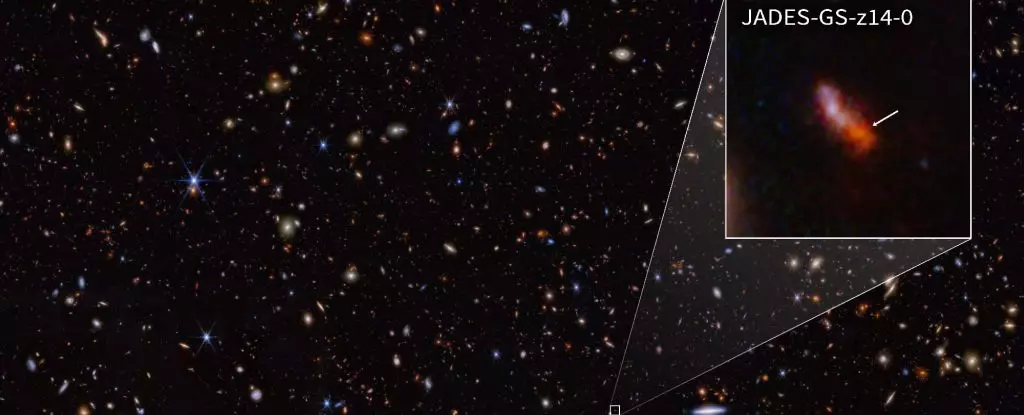A recent breakthrough in astronomy has brought to light a newly discovered galaxy that has shattered records for being the earliest seen yet. Named JADES-GS-z14-0, this galaxy is shining brightly in the early Universe, appearing less than 300 million years after the Big Bang. This remarkable find poses a significant challenge to our current understanding of galaxy formation, prompting astronomers to reconsider existing models.
In January 2024, astronomers observed JADES-GS-z14-0 using NIRSpec for nearly ten hours. The subsequent analysis of the galaxy’s spectrum revealed undeniable evidence that it has a redshift of 14.32, surpassing the previous record for the most distant galaxy. What makes this discovery even more intriguing is the fact that the galaxy spans over 1,600 light-years, indicating that the majority of the light emitted comes from young stars rather than a supermassive black hole. The sheer amount of starlight implies that JADES-GS-z14-0 is several hundreds of millions of times the mass of the Sun, raising the question of how such a massive and luminous galaxy could form in such a relatively short period.
Redefining Our Understanding of the Early Universe
The findings related to JADES-GS-z14-0 have prompted researchers to publish three separate papers on the subject. While one of these papers has been recently published in Nature, the other two are awaiting peer review on arXiv. All three papers converge on a common conclusion: the discovery of JADES-GS-z14-0 represents a groundbreaking development in our comprehension of how the Universe originated at its inception. The Cosmic Dawn, a period following the Big Bang, has remained largely enigmatic due to a fog of neutral hydrogen that obscured our view of the early Universe. However, advancements in technologies such as the James Webb Space Telescope (JWST) have allowed us to peer through this fog and gain insights into this critical epoch.
The JWST’s powerful infrared capabilities have been instrumental in conducting the JWST Advanced Deep Extragalactic Survey (JADES), which aims to identify celestial objects in the first 650 million years after the Big Bang. One of the most striking revelations from this survey is the presence of large objects much earlier than previously anticipated. Among these discoveries, JADES-GS-z14-0 stands out for its size and luminosity, challenging astronomers’ expectations of early galactic formations. Analysis of the galaxy’s light has unveiled the presence of dust and oxygen, elements that are unexpected in a galaxy of this age. These findings suggest the existence of multiple generations of massive stars that have already lived and perished within 300 million years of the Big Bang, defying conventional beliefs about stellar lifespans and galaxy evolution.
The implications of JADES-GS-z14-0’s discovery extend beyond the mere observation of a distant galaxy. This enigmatic celestial body forces us to reconsider our understanding of the early Universe, challenging the prevailing notion that the intense luminosity observed in the Cosmic Dawn can solely be attributed to growing black holes. The existence of well-formed, massive galaxies at such an early stage presents a paradigm shift in our perception of galactic evolution. JADES-GS-z14-0 emerges as a trailblazing archetype of this phenomenon, urging astronomers to rethink established theories and embark on new avenues of exploration in unraveling the mysteries of the cosmos.


Leave a Reply